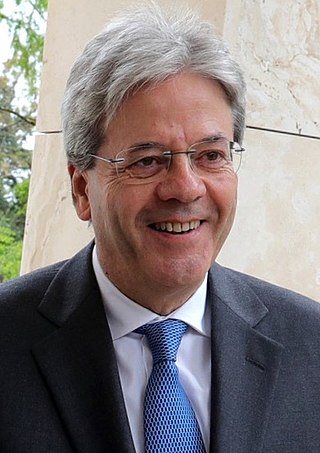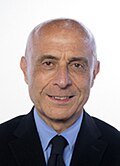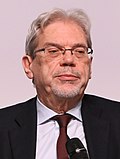Top Qs
Timeline
Chat
Perspective
Gentiloni government
64th government of the Italian Republic From Wikipedia, the free encyclopedia
Remove ads
The Gentiloni government was the 64th government of the Italian Republic, in office from 12 December 2016 to 1 June 2018. The government was headed by Paolo Gentiloni, former Minister of Foreign Affairs of the Renzi government.[1]
The government was formed after Matteo Renzi's resignation as Prime Minister, due to the result of the 2016 constitutional referendum. The new government preserved most of the ministers of the former Renzi government.[2] It was led by the centre-left Democratic Party (PD), and it originally included the New Centre-Right (NCD) and the Centrists for Europe (CpE) as junior partners. It also included a few non-party independents. The NCD was later merged into Popular Alternative (AP).
Remove ads
History
Summarize
Perspective
Background and formation

On 7 December 2016, Prime Minister Matteo Renzi announced his resignation, following the rejection of his proposals to overhaul the Senate in the 2016 constitutional referendum. A few days later, on 11 December 2016, President Sergio Mattarella asked Paolo Gentiloni, then Minister of Foreign Affairs, to form a new government.[3] On the following day Gentiloni was officially sworn in as the new head of the government.[4]
Gentiloni formed a coalition government supported by his own Democratic Party, the New Centre-Right and the Centrists for Italy. This was the same majority which supported Renzi's government for almost three years.[5] The centrist Liberal Popular Alliance, led by Denis Verdini, did not support the new government, because no party member was appointed minister.[6] Deputy ministers of the Italian Socialist Party and Solidary Democracy were also appointed. After the split of the Democratic and Progressive Movement from the Democratic Party, that party was presented by one deputy minister in the government until 3 October 2017.
Investiture votes
Remove ads
Party breakdown
Beginning of term
Ministers
13 | |
3 | |
1 | |
2 |
Ministers and other members
- Democratic Party (PD): Prime minister, 12 ministers, 3 deputy ministers, 16 undersecretaries
- New Centre-Right (NCD): 3 ministers, 1 deputy minister, 10 undersecretaries
- Centrists for Europe (CpE): 1 minister
- Solidary Democracy (DemoS): 2 deputy ministers
- Italian Socialist Party (PSI): 1 deputy minister
- Democratic Centre (CD): 1 undersecretary
- Civics and Innovators (CI): 1 undersecretary
- Independents: 2 ministers, 4 undersecretaries
End of term
Ministers
14 | |
2 | |
1 |
Ministers and other members
- Democratic Party (PD): Prime minister, 13 ministers, 2 deputy ministers, 16 undersecretaries
- Popular Alternative (AP): 2 ministers, 1 deputy minister, 8 undersecretaries
- Centrists for Europe (CpE): 1 minister
- Solidary Democracy (DemoS): 2 deputy ministers
- Italian Socialist Party (PSI): 1 deputy minister
- Independents: 3 undersecretaries
- Democratic Centre (CD): 1 undersecretary
- Civics and Innovators (CI): 1 undersecretary
- Forza Europa (FE): 1 undersecretary
Remove ads
Geographical breakdown
Beginning of term
- Northern Italy: 9 ministers
- Emilia-Romagna: 4 ministers
- Lombardy: 2 ministers
- Liguria: 2 ministers
- Piedmont: 1 minister
- Central Italy: 7 ministers (incl. Gentiloni)
- Southern and Insular Italy: 3 ministers
End of term
- Northern Italy: 7 ministers
- Emilia-Romagna: 4 ministers
- Liguria: 2 ministers
- Lombardy: 1 minister
- Central Italy: 7 ministers (incl. Gentiloni)
- Southern and Insular Italy: 3 ministers
Council of Ministers
Remove ads
Composition
- Costa resigned due to contrasts with the Prime Minister. He often criticized Gentiloni's views and ideas, especially regarding immigration and birthright citizenship.
Remove ads
References
External links
Wikiwand - on
Seamless Wikipedia browsing. On steroids.
Remove ads






















